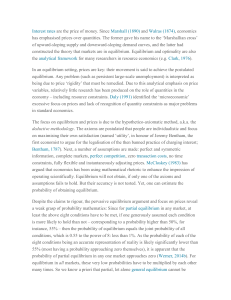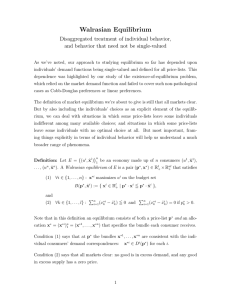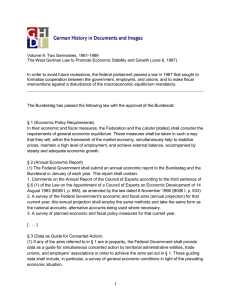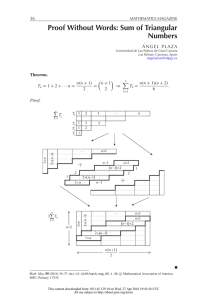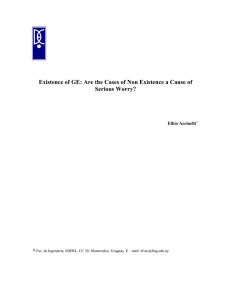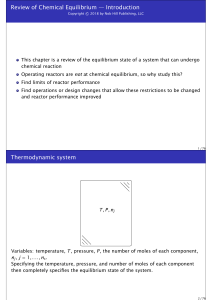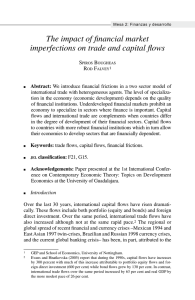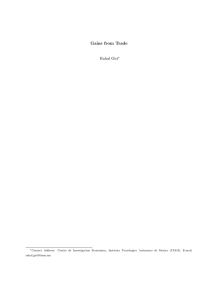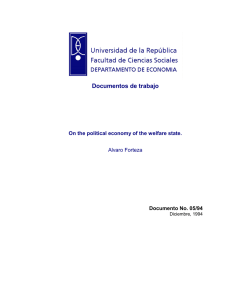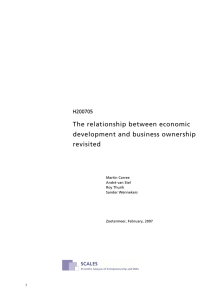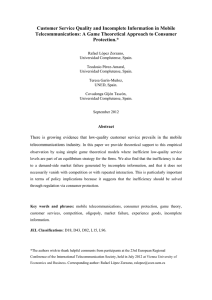A NOTE ON THE ECONOMIC INTERPRETATION OF A
Anuncio
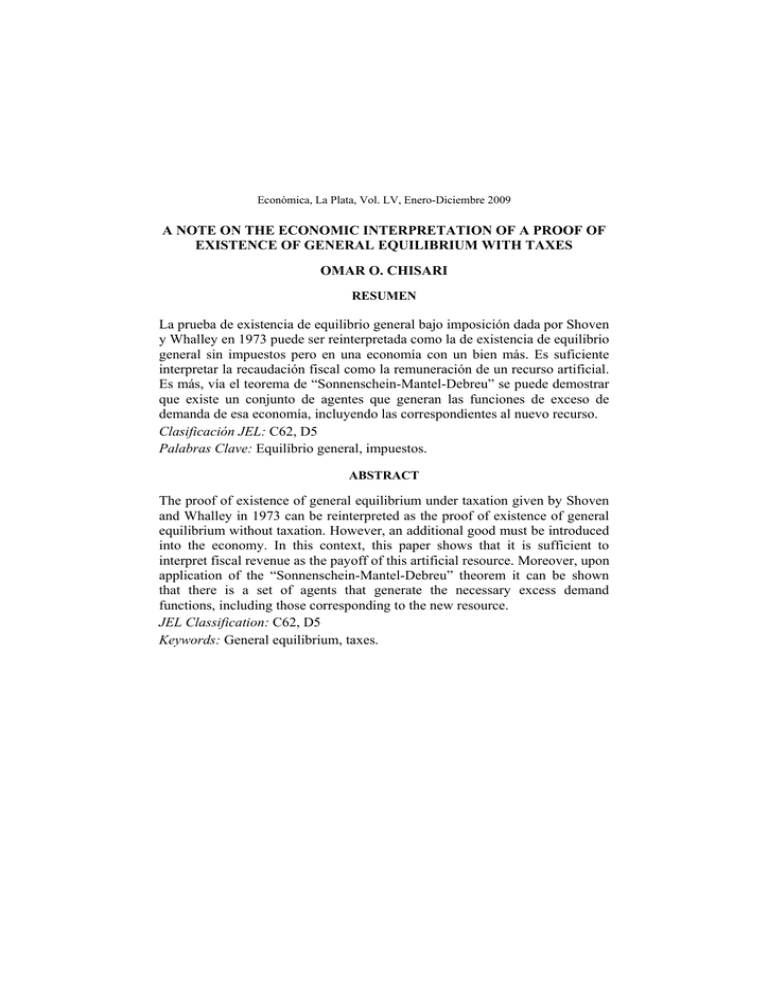
Económica, La Plata, Vol. LV, Enero-Diciembre 2009 A NOTE ON THE ECONOMIC INTERPRETATION OF A PROOF OF EXISTENCE OF GENERAL EQUILIBRIUM WITH TAXES OMAR O. CHISARI RESUMEN La prueba de existencia de equilibrio general bajo imposición dada por Shoven y Whalley en 1973 puede ser reinterpretada como la de existencia de equilibrio general sin impuestos pero en una economía con un bien más. Es suficiente interpretar la recaudación fiscal como la remuneración de un recurso artificial. Es más, vía el teorema de “Sonnenschein-Mantel-Debreu” se puede demostrar que existe un conjunto de agentes que generan las funciones de exceso de demanda de esa economía, incluyendo las correspondientes al nuevo recurso. Clasificación JEL: C62, D5 Palabras Clave: Equilíbrio general, impuestos. ABSTRACT The proof of existence of general equilibrium under taxation given by Shoven and Whalley in 1973 can be reinterpreted as the proof of existence of general equilibrium without taxation. However, an additional good must be introduced into the economy. In this context, this paper shows that it is sufficient to interpret fiscal revenue as the payoff of this artificial resource. Moreover, upon application of the “Sonnenschein-Mantel-Debreu” theorem it can be shown that there is a set of agents that generate the necessary excess demand functions, including those corresponding to the new resource. JEL Classification: C62, D5 Keywords: General equilibrium, taxes. ECONÓMICA 24 A NOTE ON THE ECONOMIC INTERPRETATION OF A PROOF OF EXISTENCE OF GENERAL EQUILIBRIUM WITH TAXES OMAR O. CHISARI 1 I. Introduction To prove the existence of general equilibrium in an economy with taxes, Shoven and Whalley (1973) constructed a simplex that included prices of goods and that considered an additional dimension, tax revenue. Why did this work? Moreover, what is the economic meaning of that analytical procedure? The intention here is to provide an answer to these questions. The paper shows that a simple reinterpretation of Walras’ Law in an economy with taxes will help understand the implicit economic rationale behind this procedure. From this reinterpretation, a proof of general equilibrium with taxes is obtained using traditional procedures. Additionally, application of the “Sonnenschein-Mantel-Debreu” theorem contributes to the mathematical description of this new economy and shows that it is based on the behavior of rational agents. Nonetheless, though illustrative, this theorem is not necessary for the proof. The rest of this paper is organized as follows. In the next section we discuss how to reinterpret fiscal revenue as an additional good. The following section will present the existence of an equilibrium in an economy with taxes. Finally, we will summarize the main results in the concluding remarks. II. Reinterpretation of Fiscal Revenue As in Shoven and Whalley’s paper, the analysis will be restricted to advalorem taxes. The main assumption is that fiscal revenue obtained from these taxes is redistributed to agents and that this redistribution does not alter the regularity properties of the excess demand functions. Therefore, following Shoven and Whalley, the excess demand functions of all goods Zi (p, R), i= 1, …n , are defined as continuous and homogenous of degree zero in prices and 1 Instituto de Economía de la Universidad Argentina de la Empresa and CONICET (Argentina), [email protected]. I am grateful to Fernando Tohmé and to an anonymous referee for their interesting comments. A NOTE ON THE ECONOMIC INTERPRETATION OF A PROOF … 25 tax revenue, denoted by p and R respectively. These demand functions fulfill Walras’ Law in an economy with taxes, i.e.: pZ(p,R) + t(p,R) – R ≡ 0 (1) for all non-negative p and R. Notice that this last expression can be easily rewritten as: pZ(p,R) + R[t(p,R) /R –1] ≡ 0 (2) The last term of expression (2) can be reinterpreted as the excess demand of an artificial good, whose endowment is 1 and its associated price is R. The excess demand function for that artificial good, let us call it “revenue”, is continuous and homogenous of degree zero for R > 0 since t(p,R) is continuous and homogenous of degree one in prices and revenue. This second property is a consequence of the assumption that taxes are ad-valorem. Thus when divided by R, fiscal revenue becomes homogeneous of degree zero in (p, R). One important reason why R also enters as an argument in the excess demand functions relates to the prior assumption that revenue is redistributed amongst agents in the economy. Therefore, we can state that the second term in (2) can be interpreted as an excess demand function which is multiplied by its corresponding price, R. But, could it represent any economy? To answer this question, let us resort to the well known “Sonnenschein-Mantel-Debreu” theorem (see for example MasColell et al, 1995, Chapter 17). This theorem proves extremely useful to understand that even very complicated excess demand functions may be admissible in theoretical economies, and also has shown the many shortcomings in the analysis of equilibrium stability. According to this theorem, for any set of excess demand functions that are continuous, homogenous of degree zero in prices, and that fulfill Walras’ Law, there is always a set of rational consumers which generate them. Hence, in an economy with this additional artificial good –defined here as “revenue”- there will be always a set of agents with individual endowments and well-behaved utility functions whose aggregate excess demand functions will generate the Zi(p,R) and t(p,R) /R–1 (though possibly in a restricted domain for p and R -see Mas-Colell et al (op.cit), Proposition 17.E.3). The existence of an equilibrium for this economy with taxes can be shown in a straightforward way as if it were an economy without taxation. ECONÓMICA 26 III. Proof of existence of equilibrium As stated above, proof of the existence of an equilibrium in an economy with ad-valorem taxes can be shown by using already available proofs for an economy without taxes –see for example Varian (1992). Define i=1,…,n, and j,k=1,…,n+1. Let “revenue” be good n+1 and Zn+1 (p,R) = t(p,R) /R –1. Also define the new vector of prices q as (p,R), hence qn+1 = R. Now proceed as in any traditional proof of existence of general equilibrium without taxes. Let G(q) be a vector function that takes elements in the simplex defined by {qj ≥ 0, ∑j qj = 1, j =1, …, n+1} onto the same simplex, and such that for every k: Gk (q) = {qk + Max [Zk (q), 0]}/{1 + ∑j Max [Zj (q), 0]} (3) More explicitly, the component corresponding to “revenue” is: Gn+1 (p,R) = {R + Max[t(p,R) /R –1, 0]} /{1 + ∑j Max [Zj (q), 0]} (4) These are continuous functions of all prices (including “revenue”), and the simplex defined by (p, R) is closed, bounded, and non empty. Therefore Brouwer’s theorem guarantees the existence of a fixed point in that simplex. The second part of the proof consists in showing that this price vector is the equilibrium price vector. Let q* be that fixed point; then G(q*) = q* and consequently, for all goods and “revenue”: qk* {1 + ∑j Max [Zk (q*),0]} = {qk* + Max [Zk (q*), 0]} (5) it follows that: Zk(q*) qk* ∑j Max [Zk (q*),0]} = Zk(q*) Max [Zk (q*), 0] (6) for all goods. Adding up over k: {∑k Zk(q*) qk* }{∑j Max [Zj (q*),0]} = ∑k Zk(q*) Max [Zk (q*), 0] (7) From (2), ∑i Zj(q*) qj * = 0, and therefore: 0 = ∑k Zk(q*) Max [Zk (q*), 0] (8) The expression on the right contains only non-positive terms, since if it included a positive term, it would not be possible to compensate with a negative value to reach the null result -since the maximum between Zk (q*) and zero applies for every good. Therefore, at q*, we have Zk (q*) ≤ 0 for all k. This is the basic definition of equilibrium prices in its weak version, for there will be no goods with excess demand. This concludes the proof. A NOTE ON THE ECONOMIC INTERPRETATION OF A PROOF … 27 Will the equilibrium price vector be an interior solution in the simplex? Although all prices will not be zero at the same time, since they must belong to the simplex, some of the goods may have price zero in equilibrium (“freegoods”) if they are in excess supply. Shoven and Whalley explicitly exclude a neighborhood of R =1. To maintain the more traditional interpretation given here, prices can be prevented from being zero in equilibrium by including a “desirability” assumption: when the price of a certain good nears zero, its excess demand function will approximate to a positive number. For “revenue”, since Zn+1 (p,R) = t(p,R) /R –1, this assumption may be structured as follows: if R is too small, then t(p,R) /R will approximate a large positive number, greater than 1. Is this a reasonable assumption? It is plausible to think that, given legal ad valorem taxes, there would be a tax collection of positive amount even when it were not transferred to agents, i.e. t(p,R) > 0, for all R ≥ 0. IV. Concluding remarks Most applied computable general equilibrium models include domestic taxes, mark-ups or trade taxes, and owe much to Shoven and Whalley’s proof of the existence of general equilibrium in an economy with taxes. However, their paper lacks an explanation of why their procedure (enlargement of the simplex) worked so well. It was shown here that ad-valorem taxes can be interpreted as defining an implicit demand for a shadow resource (fiscal revenue). Then, the proof of existence of equilibrium can proceed as in the traditional methodologies. The excess demands for the new set of goods (the previous ones plus fiscal revenue) can be obtained from a set of artificial rational agents –thanks to the “Sonnenschein-Mantel-Debreu” theorem. Both proofs, the one presented here and that of Shoven and Whalley’s, depend on the assumption that tax revenue is distributed to agents in a way that does not alter the regularity properties of the excess demand functions. 28 ECONÓMICA References Mas-Colell A., M.D.Whinston and J.R.Green (1995). Microeconomic Theory. Oxford University Press. Shoven J.B. and J.Whalley (1973). “General Equilibrium with Taxes: A Computational Procedure and an Existence Proof.” The Review of Economic Studies, Volume 40 (4): 475-489. Varian H. (1992). Microeconomic Analysis. New York: W.W.Norton.
